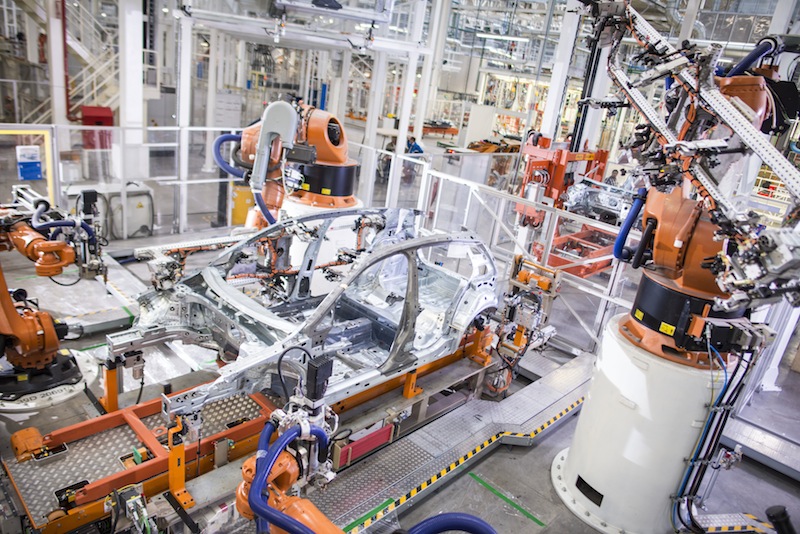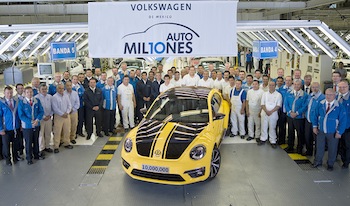A veteran of vehicle production in the country, VW is nonetheless still expanding at Puebla – adding a new bodyshop for the Golf last year and another for the Tiguan that will open in 2017. AMS went to look around
At 550,000 sq.m on 3m sq.m of land, VW Puebla is second in size only to Nissan Aguascalientes within Mexico, but this expansive manufacturing complex is set to get even bigger with an investment of $1 billion that was announced in March this year to build and equip a 90,000 sq.m bodyshop for the new Tiguan SUV. From an installed capacity of 500 units per day, the facility will supply the Americas and other markets around the world, excluding the EU and China. VW has stated that there will be a “high level” of automation in the bodyshop, with “advanced programming and control systems” – making it similar to the Golf 7 bodyshop that was opened last year at a cost of $700m.
The move is part of VW’s localisation strategy for production, which Michael Horn, president and CEO of VW Group of America, described as “key to safeguarding our competitive position on the global market”, noting that it will improve access to the US market. “With production of the Golf A7 and the Tiguan now moved to Puebla, we will build approximately 90% of our products in the NAFTA region,” he said.
However, unlike other global OEMs which are only now moving to take advantage of Mexico’s free-trade agreements, low-cost labour and proximity to the US, VW has had a manufacturing presence in the country for no fewer than five decades, investing around $10 billion since 1964 (see timeline below).
Size: 550,000 sq.m on 3m sq.m
Location: Puebla
Origins: SOP 1965, launching with the Beetle
Recent upgrade: $700m in 2014 for new Golf 7 bodyshop; $1 billion announced in March 2015 for new Tiguan bodyshop
Line-up: Jetta 6, New Beetle 2 (coupe and convertible), Golf 7 (hatchback and station wagon); three-row Tiguan from 2017
Output in 2014: 475,000 units
Shifts and workforce: 16,452, three shifts Monday-Friday; one or two Saturday, depending on demand
While the Beetle and Jetta have their own bodyshops (and assembly halls), the new Golf 7 bodyshop is the outstanding facility. Illuminated by natural lighting, it covers 49,000 sq.m (with space to store 2,500 bodies) and is equipped with 800 robots, mostly from Kuka; the automation level is 80%. The bodyshop is fed by the nearby, 6,048 sq.m press shop which is automated by two Mueller Weingarten presses stamping steel from Germany, Japan and Korea at a rate of 16 pieces per minute. Most of the joining that takes place in the bodyshop is spot welding, but adhesives and laser welding are used for the side bodies. Sensors measure the dimensions of the joined bodies but the final check is completed by workers operating under strip lighting; the total bodyshop workforce is 795. The cars then go to the paintshop, which is almost fully automated with Dürr robots.

VW now has around 250 suppliers in Mexico, more than 50 within a 50km radius of the plant, and last year the OEM sourced around 70% of its purchasing volume from within North America.
All the parts that are received in the hall are transferred to a midpoint between the delivery area and final assembly, mostly by electric, manually guided vehicles. Assembly then follows the Kanban philosophy, with each station keeping a pair of component containers at all times, one full and one empty.
Puebla produces engine parts at its own foundry and assembles 2.0-litre and 2.5-litre engines for the Jetta, but also receives 1.8-litre and 2.0-litre units for the Golf and Beetle from the 330,000-capacity engine plant at Silao in Guanajuato, which opened in January 2013 at a cost of $550m (and also supplies VW’s Chattanooga plant in Tennessee). In the assembly hall, the engines are raised to meet the bodies, with a tolerance tinier than a hair.
All of the vehicles completed at Puebla are track-tested for the full range of characteristics, including noise, brakes, electronics and water, before exiting the site. Exports to the US leave by train on a daily basis, others are sent to the ports for overseas distribution and a small proportion, just 15%, are transported by truck for the local market. Puebla is currently producing 2,150 units per day – but with the addition of the new Tiguan bodyshop to supply the popular SUV market in the US, that number will surely rise.
Related story: Interview with Thomas Karig, vice-president of corporate affairs, VWdM
1954: Subcontracted assembly of completely knocked down Beetles
1964: Acquisition of Beetle assembler Promexa and creation of Volkswagen de México (VWdM), in response to new local content regulations (60% by value)
1965: VW’s assembly of Beetles hits 13,000 units; work begins on establishing Puebla plant (press shop, bodyshop, engine and axle facilities, final assembly hall)
1967: First Beetle produced in October
1976/77: High losses owing to national economic instability; workforce cut by 25% to 7,550
1979: Workforce up to 10,900, reflecting higher sales generated by Golf and basic Transporter launch, Beetle exports to Europe (replacing German production), commencement of parts supplies for US-built Rabbits, and a reviving economy
1981: Press shop expansion and construction of engine production facility
1994: Third-generation Golf and Jetta production transferred from shuttered Westmoreland plant, US, with $800m invested to expand capacity to 350,000 units and modernise production, boosting quality and productivity; supplier park established
1998: $1.5 billion invested for new Beetle, built exclusively at Puebla and exported worldwide; old and new models both assembled until 2003
2009: Global financial crisis drops production to 320,000 units, but expansion plans continue, including next-generation Jetta capacity increase and decision to establish new engine plant outside Puebla
2010: Jetta production rises to 2,500 per day; Silao selected for new, 76,000 sq.m engine plant on 600,000 sq.m in Guanajuato
2011: The Beetle commences production; Puebla produces 510,000 units in total and becomes largest car plant in Mexico
2012: Beetle Cabriolet added to production line-up; record 604,000 units made
 2013: VWdM celebrates 10m vehicles made in Mexico
2013: VWdM celebrates 10m vehicles made in Mexico
2014: New bodyshop enables Golf 7 to become first MQB vehicle made in Mexico; 50th anniversary of VWdM
2015: Work begins on $1 billion expansion for new, three-row Tiguan SUV.






































